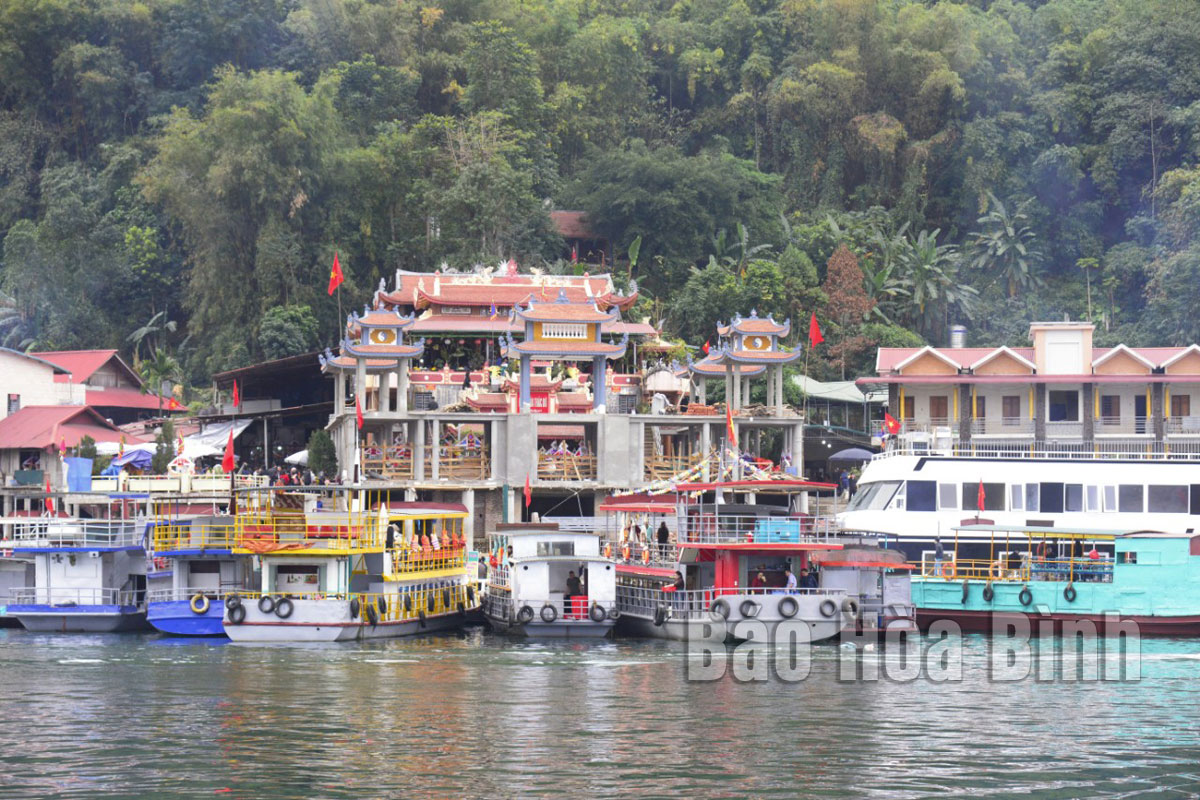



Every year, Thac Bo temple in Thung Nai commune (Cao Phong) attracts a large number of tourists to visit and worship.
For a long time, Ms. Le Thi Huong from Ha Dong district (Hanoi) has not returned to visit Muong Thang. On this occasion, when the children were on summer vacation, she took the whole family to Cao Phong - where she worked for a short time. Ms. Huong says: In the district, there are unforgettable places for us. These are Thung Nai with vast lake water, Thac Bo temple, Muong Giang Mo village, Dau Rong mountain, Vietnam Scientists Heritage Park, Khanh pagoda historical relic site, Quoen Ang pagoda... Together with that, it is the cultural identity of the Muong ethnic group and delicious products from sugarcane and oranges... These are the favorable conditions for developing various types of community tourism, weekend resort, eco-tourism, spiritual and sacred tourism...
Mr. Bui Yen Minh, the Deputy Head of Culture and Sports Department of Cao Phong district says: In recent years, the district has had many activities to develop tourism. The district has paid attention to building and implementing tourism development planning. Accordingly, it is suggested continuing to plan the construction of the following tourism routes: Binh Thanh - Thung Nai - Da river lake bed: tourism to the ancient ethnic villages (Muong, Dao) with the traditional craft villages of knitting, brocade weaving; Cu Chinh Lan heroic historical relic site, Bo temple, the eco-tourism within Hoa Binh lake area, community tour in Tien hamlet, Thung Nai commune, Mo hamlet, Binh Thanh commune. Hop Phong - Dung Phong - Thach Yen tourism route includes: The historical and cultural relic of Quoen Ang pagoda, the flower garden on Coi mountain in Hop Phong commune, Khanh pagoda in Thach Yen commune; tourism in Rom Khanh village, Thach Yen commune. Cao Phong - Hop Phong town tour route includes: Eco-tourism of orange and sugar cane orchards; tourism to Can Thuong lake; Muong ethnic minority village in Can and Mung hamlets (Hop Phong). The tour route Vietnam Scientists Heritage Park, the national scenic area of Dau Rong mountain cave complex, Thuong Bong Lai temple, Dong Son temple in zone 3, Cao Phong town.
The district also encourages building the works with typical architecture of ethnic minorities, associated with the exploitation of human resources and highlights the cultural identity of the local ethnic minorities with a unique cultural identity, creating attractions for tourists. The functional branch has propagated and mobilized the people in Mo village, Binh Thanh commune; Tien village in Thung Nai commune, Mung village in Hop Phong commune to improve the community awareness and the skills to welcome guests, cleaning up the environment, practicing more new musical performances. They have also encouraged the local people in Rom Khanh hamlet, Thach Yen commune to continue preserving the national cultural identity to develop community tourism.
In addition, the district has been paying attention to training and fostering the professional skills and tourism skills for the people in tourism areas and spots. They have been focusing on propagating the current laws, decrees and circulars on tourism; Introducing the code of civilized tourism behavior. So farr, in the district there have been 20 accommodation establishments with over 200 rooms, including 17 motels, 3 community tourism sites, attracting 1,700 employees working in the field of tourism.
According to the tourism steering committee of Cao Phong district, the tourism activities in the first 6 months of 2023 have prospered. The number of visitors in the district has been more than 221,800 turns, increasing 135.3% over that of the same period last year. Of which, there were 636 turns of international visitors and nearly 221,170 turns of domestic visitors. The revenue reached 135 billion dongs, increasing 214.2% over that of the same period. The district is mobilizing the resources for infrastructure investment and tourism development as planned. It is necessary to focus on promoting, attracting investment, encouraging the community to participate in tourism activities; promoting the socialization of tourism development. In addition, the district continues to open training courses for the community villages and sites, the motels, tourism cooperatives; developing the preferential policies for businesses to attract investment in the field of tourism...